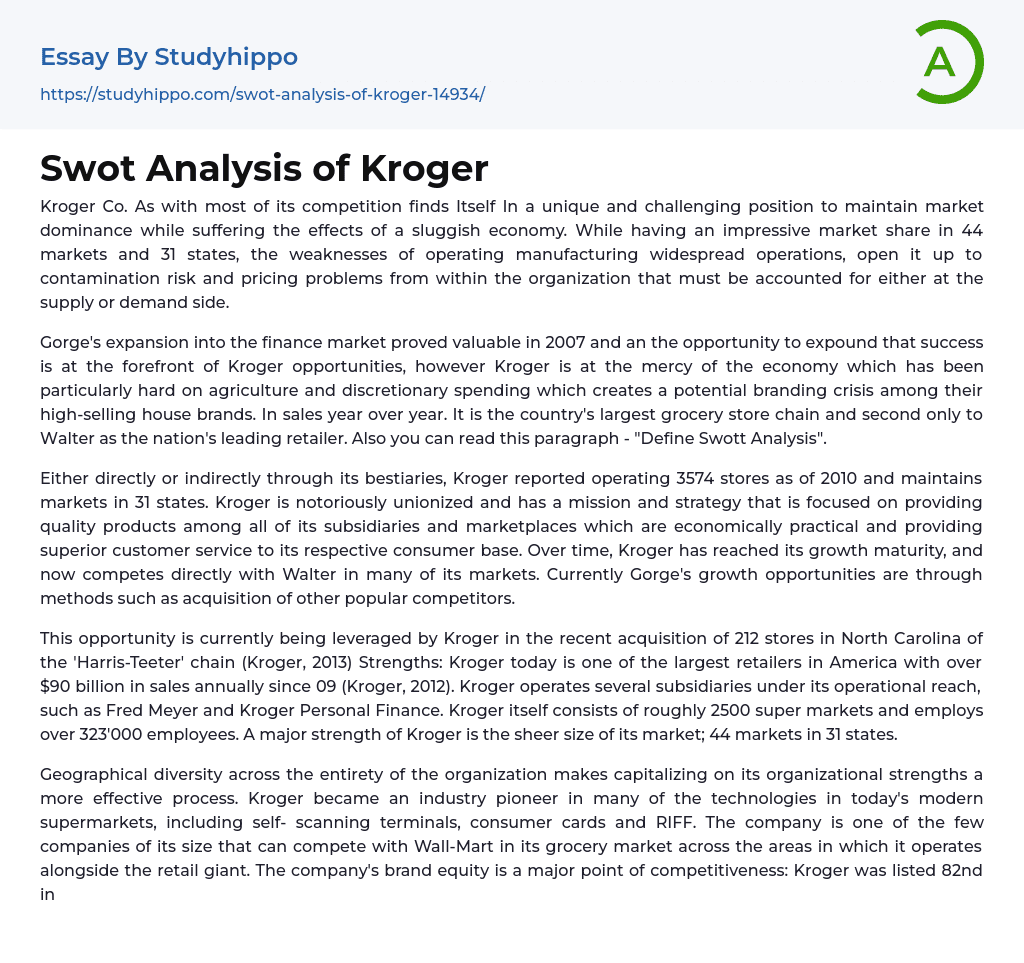Kroger Co. and its competitors face the challenge of maintaining market dominance in a sluggish economy. Despite its impressive market share in 44 markets and 31 states, Kroger's widespread operations make it vulnerable to contamination risks and internal pricing issues that need to be addressed in the supply or demand side.
Gorge's expansion into the finance market in 2007 was valuable. Kroger sees an opportunity to build on that success. However, they are dependent on the economy, which has been tough on agriculture and discretionary spending. This poses a potential branding crisis for their high-selling house brands in terms of year-over-year sales. Kroger is the country's largest grocery store chain, second only to Walter as the nation's leading retailer. You can also read this paragraph - "Define Swott Analysis".
Kroger, known for its unionized workforce, operates 3574 stores across 31 states
...as of 2010. With a mission and strategy centered on offering economically feasible quality products and superior customer service throughout its subsidiaries and marketplaces, Kroger has reached its growth maturity. It now directly competes with Walter in multiple markets. To expand further, Kroger explores growth opportunities such as acquiring other well-known competitors.
Kroger is currently leveraging this opportunity through the recent acquisition of 212 stores in North Carolina from the 'Harris-Teeter' chain (Kroger, 2013). Kroger is one of America's largest retailers with annual sales exceeding $90 billion since 2009 (Kroger, 2012). It operates subsidiaries such as Fred Meyer and Kroger Personal Finance. With approximately 2500 supermarkets and over 323,000 employees, the sheer size of Kroger's market presence is a major strength, covering 44 markets in 31 states.
The organization benefits from its geographica
diversity, which allows for more effective utilization of its organizational strengths. Kroger has played a pioneering role in the implementation of various technologies found in modern supermarkets, such as self-scanning terminals, consumer cards, and RIFF. It is one of the few companies in its industry that can rival Wall-Mart in the grocery market where they both operate. Kroger's brand equity is a significant competitive advantage; it ranked 82nd in the Global 500 Brand list.
According to Ranking the Brands. Com and the Reputation Institutes, Kroger is considered one of the top 20 most reputable companies. This recognition has been beneficial for Kroger as it faces a series of negative earnings forecasts. Kroger has implemented a three-pronged branding strategy which includes private selection, banner brands, and Kroger Value. Private selection represents Kroger's upscale brands, while 'Kroger value' offers quality products at more affordable prices. Kroger's banner brands consist of subsidiary brand items that use the company's private labels (such as Rally's and King).
Coopers etc. ). However, Kroger Co faces challenges common to large organizations with a comparable scope. As a competitor in 44 markets, Kroger relies on numerous suppliers, who may experience price fluctuations for reasons beyond Gorge's control. Additionally, operating in the food industry puts strain on supply chains, which must accommodate the nature of the goods being transported. Gorge's supply chain technology is not as advanced as that used by Walter and other more efficient supply chains.
The potential risk of contamination in the supply chain can negatively impact brand loyalty and quality control. Additionally, Gorge's unionized workforce puts it at a disadvantage compared to competitors with lower labor costs. However,
Kroger Personal Finance, LLC (a collaboration between Kroger Co. and U.S. Bank) provides successful financial and checking/debit services for the company. Nevertheless, its performance is dependent on the state of the economy. In light of the current economic climate, leveraging Gorge's three-pronged merchandising strategy presents an immediate opportunity by promoting its own product line alongside over 14,000 other brands to increase profit margin and reduce reliance on external brands.
During the fourth quarter of 2009, Gorge's private label brands made up 27% of their total grocery sales (Kroger, 2010). At the same time, Kroger revealed a bold growth strategy. Through strategic districting, Kroger aimed to expand its services to various markets where customer loyalty towards Kroger brands was already strong. However, there are potential threats to Kroger's success. Being a unionized company, Kroger is vulnerable to increasing labor costs as a result of changes in regulations, fluctuations in public opinion regarding minimum wage laws, and general economic inflation.
When unions negotiate, it can benefit employees but may also increase the company's profit margins. This could lead to higher prices for consumers and a decrease in sales. In today's slow economy, both Kroger and its competitors face challenges that require constant monitoring and adjustments by sales analysts. As a large organization, Gorge must stay informed about how economic conditions affect different operational aspects, even those beyond their control.
The agricultural industry is particularly concerning because it serves as the cornerstone of Gorge's competitive strategy, unlike Walter and other diverse industry competitors. Kroger's higher-end prong of its three-pronged Branding Approach may experience a decline in profit margins as spending on luxury brands decreases during challenging economic times.
- Wal-Mart essays
- Discover essays
- Advertisement essays
- Advertising essays
- Anheuser-busch essays
- Audience Theory essays
- Brand essays
- Brands essays
- Competitor Analysis essays
- Consumer essays
- Detergent essays
- Marketing Management essays
- Marketing Mix essays
- Marketing Plan essays
- Marketing Research essays
- Marketing Strategy essays
- New Product Development essays
- Point Of Sale essays
- Price essays
- Procurement essays
- Product essays
- Product Differentiation essays
- Product Placement essays
- Promotion essays
- Promotion And Marketing Communications essays
- Research Design essays
- Retailing essays
- Trademark essays
- Adidas essays
- Amazon essays
- Apple essays
- Bmw essays
- British Airways essays
- Burger King essays
- Coca-Cola essays
- Company essays
- Costco essays
- Dell essays
- Ebay essays
- Enron essays
- Facebook essays
- Ford Motor Company essays
- Gap essays
- General Motors essays
- Google essays
- Honda essays
- Ibm essays
- Ikea essays
- Intel essays
- Iphone essays




